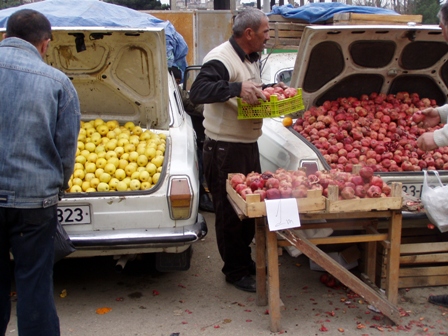Visiting clients in a small city in Azerbaijan
March 16, 2008
Greetings! My name is Ai Li Ang and I live in Chicago, Illinois, in the USA. I was born and grew up in Malaysia and am ethnically Chinese (this detail will be relevant later on). I arrived in Azerbaijan as a Kiva Fellow to work with one of Kiva’s partners, Norwegian Microcredit (Normicro). This is the second time that Normicro is hosting a Kiva Fellow. Since the previous Fellow, Liz Vallette, departed in fall of 2007, Normicro has continued to experience tremendous growth in number of clients served and loan portfolio. In less than a year, Normicro has added 2 branch offices to the 5 it had last year, improving access to microloans for many low-income and internally-displaced persons in Azerbaijan.
Last week, I ventured outside the capital city of Baku (where Normicro’s head office is located) to visit a branch office (where loans are administered) for the first time. My goal was to interview clients who received loans from Kiva lenders, write journals, and upload the journals to Kiva.org. Getting to Khachmaz, a city north of Baku, was relatively easy for someone who doesn’t speak Azeri or Russian. Minibuses, known as “mashrutkas”, line up outside one of Baku’s main bus stations with clearly labeled signs of their destinations. As far I know, the mashrutkas don’t follow schedules, but depart as soon as each vehicle fills up. For most low-income Azeris, mashrutkas are the most reliable and affordable means of traveling to other cities. However, the 3 manat (approx. 3.60 USD) one way, 2.5 hour bumpy journey is not for the faint-hearted. Many times the driver would pass slow trucks in spite of on-coming vehicles, swerving back to his own lane only at the very last minute. Sometimes, when the driver overestimated his mashrutka’s horsepower on a passing attempt, he would resort to creating an additional middle lane.
During my 3 days at Normicro’s Khachmaz branch office, the two loan officers, Vagif and Nafira, were quite busy meeting with clients at the office. Yet, they took some time off in the afternoons to take me to see borrowers of Kiva loans. I also received translation help from a U.S. Peace Corps volunteer, Adam. Most of the clients we visited operated retail (e.g., clothes, groceries, shoes, furniture) business. Very quickly I got consistent replies that the loans were used to purchase inventory in bulk to get lower prices. This implies that the additional profit margin from lower cost of goods was more than sufficient to offset the 3% monthly interest rate charged by Normicro. Access to loans essentially accelerates the rate at which these entrepreneurs accumulate profit and grow their businesses. Many of them also expressed the desire to take larger loans so that they can make one-time infrastructure investments or buy inventory in even larger quantities.
In a small city such as Khachmaz, when two foreigners walk through the bazaar and talk to people, all buying and selling activities are paused because everyone gathers around to listen to our interviews! Each one of us also draws attention for different reasons: Vagif and Nafira, the loan officers, were constantly approached by current and potential clients with inquiries; Adam, a caucasian, was considered the rich investor who would provide the loan capital; I, on the other hand, was asked directly or indirectly what I was selling! (Chinese in Azerbaijan are typically seen selling toys and misc. items on sidewalks and on the streets.)
/>PREVIOUS ARTICLE
Kiva and Halloran Philanthropies to host a Microfinance Reception in Philadelphia →NEXT ARTICLE
Soccer Does Promote Social and Economic Development →














